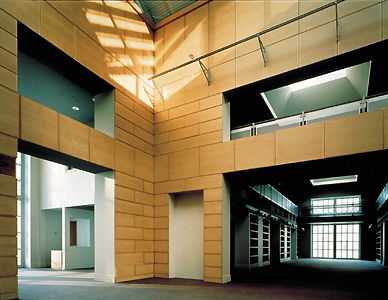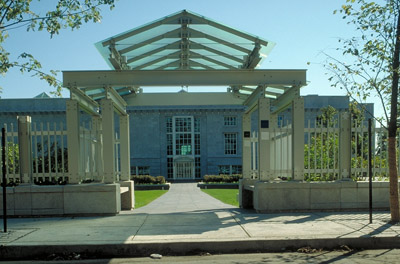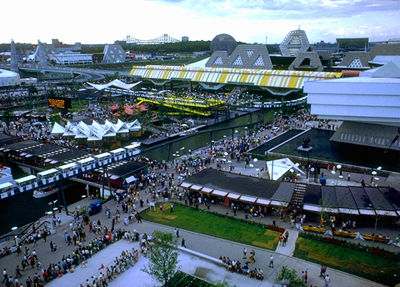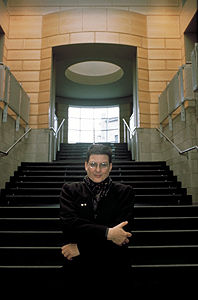Raymond Moriyama, CC, OOnt, architect, planner (born 11 October 1929 in Vancouver, BC; died 1 September 2023). Raymond Moriyama is recognized for several landmark buildings both in Canada and abroad. He is renowned for his sensitivity in considering and addressing human scale, for his humanistic approach to design, and his ability to connect architecture with nature and landscape.

Early Years and Education
Raymond Moriyama’s early years involved a complex set of circumstances through which he developed both a sense of drive and intuition. Due to their Japanese heritage, he and his mother and sisters were sent to an internment camp in western Canada during the Second World War. (See also Japanese Canadians; Internment of Japanese Canadians.) Despite these challenges, his family’s influence nurtured a sense of forgiveness and openness, lending Moriyama a clear sense of purpose from an early age. During these years, his love of nature grew and has remained with him ever since.
Moriyama was educated at the University of Toronto and McGill University. He began to practice architecture in Toronto in 1958. His early work was tied to the Crothers family, for whom he produced a variety of projects such as the Used Equipment Centre, built of scrap iron. His work in this period is perhaps best exemplified by the Japanese Canadian Cultural Centre (1963) in Toronto. His largest commission as an independent architect before entering into partnership with Ted Teshima is the Ontario Science Centre (1969) in Toronto.
Moriyama & Teshima
In 1970, Raymond Moriyama went into partnership with Ted Teshima to form the architectural firm Moriyama & Teshima. Recognition for their projects quickly accumulated, as they received the Governor General's Medals for Architecture for the Scarborough Civic Centre (1973), The Metropolitan Toronto Reference Library (1977) and Sudbury's Science North (1984).
Moriyama’s work has ranged in scale from the design of an award-winning Japanese ceremonial bell, the Goh Ohn Bell (1977) at Ontario Place, to long-term, environmentally sensitive planning projects such as the vast master plan for Saskatchewan's Meewasin Valley (1979) and the 100-Year Vision for Niagara Falls (1988).
One of Moriyama’s most publicized projects is the Canadian Embassy in Tokyo (1991), located on a prestigious site adjacent to the Akasaka Imperial Grounds and the Takahashi Memorial Park in Tokyo. The building’s unique roof was informed by the city’s design restrictions, which required that the new embassy building cast limited shadow on the Imperial Grounds and Takahashi Memorial Park. The embassy features great spaces within that allow for transparency and accessibility; it has also become a meeting place for Canadians and Japanese.

In 1995, Moriyama completed the Bata Shoe Museum in Toronto. The project is celebrated for its sculptural qualities and the beautiful interplay between its outward tilting limestone façade and its two-storey, pyramid-shaped glass entry. In 1996, construction was completed on another innovative project, Casino Rama, a casino built on the reserve land of the Chippewas of Rama First Nation. (See also First Nations in Ontario; Reserves in Ontario.)

After winning an international competition, Moriyama & Teshima designed the National Museum of Saudi Arabia, which opened in the capital city, Riyadh, in 1999. Working with several international partners, the firm designed a remarkable building that incorporates welcoming courtyards, water, and a sweeping wall faced in local limestone.
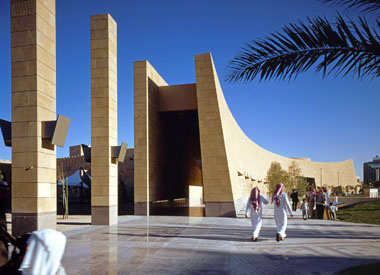
The Canadian War Museum
The Canadian War Museum in Ottawa, which opened in May 2005 (designed as a joint venture with Griffiths Rankin Cook Architects, now GRC Architects), serves as a fitting culmination to Raymond Moriyama’s career. This landmark project is devoted to exploring the themes of memory, regeneration and the human condition. The building features bold and visually striking geometries and artistically layered materials. The horizontal expression of the building on the site is further explored in the interior, which features soaring, dramatic spaces filled with natural light. Moriyama described the genesis of the building as well as its underlying meaning in his book In Search of a Soul: Creating the New Canadian War Museum (2006).
Retirement
Raymond Moriyama retired from Moriyama & Teshima in 2003and a new generation has assumed direction of the architectural firm. Moriyama's sons Ajon and Jason Moriyama became partners of the firm. Ajon Moriyama established his own practice in 2013.
Moriyama has stated that for him, "architecture is a relentless, investigative process that must be concerned with human, ecological, technical, economic, and aesthetic issues," and his work embodies that principle.
Other Pursuits
Raymond Moriyama became the sixth chancellor of Brock University in 2001. He served as chancellor of the university until 2007.
In 2013, Moriyama, the Royal Architectural Institute of Canada (RAIC) and the RAIC Foundation established the RAIC International Prize (formerly the Moriyama RAIC International Prize). Awarded every two years, the RAIC International Prize celebrates architecture “that transforms society and promotes justice, respect, equality, and inclusiveness.”
Honours and Awards
Raymond Moriyama was the recipient of numerous awards and honours, including the 2010 Sakura Award from the Japanese Canadian Cultural Centre in Toronto. He received this award for his work on the centre’s original building and for his life-long contributions to Japanese culture in Canada and abroad. He was made a member of the Order Of Ontario (1992) and the Order of the Rising Sun (Japan). Moriyama was also named an Officer of the Order of Canada (1985) and later appointed an Companion (2008). Other awards include the Gold Medal from the Royal Architectural Institute of Canada (1997), the Confederation of Canada Medal and a Lifetime Design Achievement Award from the Ontario Association of Architects (2012). Moriyama has also won Governor General's Awards in Visual and Media Arts (2009) and has been granted honorary degrees from numerous universities. Adding to this rich repertoire are several awards for material innovation, urban design, as well as lighting design.

 Share on Facebook
Share on Facebook Share on X
Share on X Share by Email
Share by Email Share on Google Classroom
Share on Google Classroom






